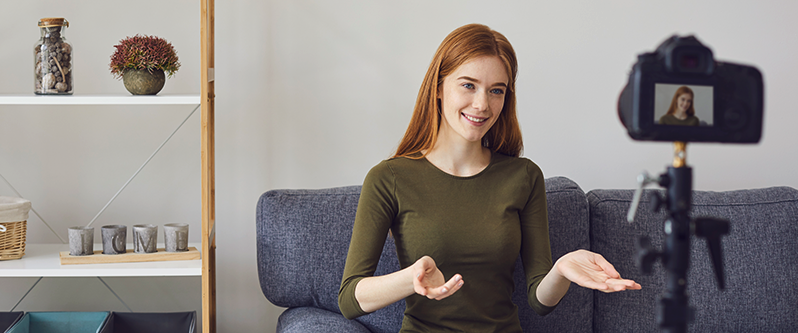
Shooting How-to Videos: 9 Best Practices
The goal of how-to videos is to provide viewers with an audio and visual guide to accomplish something in an easy-to-follow, step-by-step process.
So, it’s important to make sure that your video quality helps communicate the steps easily and without fail.
If you’re new to recording how-to videos, below are things you must prepare before you hit “record.” This way, you ensure that your videos meet your standards of quality and help viewers learn what they need to learn about in the video.
#1 – Plan Your Video Ahead of Time
When recording your how-to videos, you must have a clear idea of how you want to video to come out and what you must do to achieve it.
To do this, you must set out the goals of your video.
Aside from teaching viewers how to perform something, you also need to worry about how you wish to communicate the steps. Some take the serious and professional route, while others inject humor into the video.
There are many types of videos, and regardless of which type you go with, your objective is to help make the information easily digestible. Knowing who your audience is and what they want to see from you is crucial to achieving your goals.
#2 – Prepare the Equipment for the Shoot
The camera and the microphone are two of the most crucial pieces of equipment you’ll need to create how-to videos. And the types of equipment you’ll have will dictate their overall quality.
Regarding the camera, a mobile phone that can record 4K videos at 60 frames per second (FPS) should be more than enough to help you create this video type. If you own an iPhone 13 Pro or similar, you are ready to move on to the next step.
If you’re recording how-to videos in front of your camera, a webcam is what you need. Aside from frame rate and resolution, you want one that automatically corrects low light and ensures that you look good in the video. There’s also the mounting feature you have to worry about for better alignment of your face or body with the camera.
As for the microphone, there are two mic types to choose from. Dynamic microphones are great for noisy environments in a live setting as they can pick up loud sounds while drowning out the rest. On the other hand, condenser mics are more sensitive to sound in higher frequencies like voice.
If you have a soft voice, you’re better off using condenser microphones. Dynamic mics will record your voice much better for those who have a loud and rich voice.
#3 – Stabilize Your Camera
If you’re using a webcam, mounting them onto the screen of your laptop or PC ought to do the trick. But this only works if you’re not making too much movement on the table where the PC screen is.
For digital or phone cameras, you’d need a tripod to keep things steady. This will come in handy, especially when you’re presenting the different steps to your viewers.
But if you’re required to move around during the how-to video, you’ll need a camera with built-in image stabilization (IS). Or at least have an external IS you can use for this purpose. This allows you to take how-to videos without making viewers dizzy due to too much movement.
As a last resort, most video editing software has an image stabilizer you can use to cut down the unnecessary movement from your camera. However, it won’t solve anything unless you can minimize the shakiness of your camera using an external IS first.
#4 – Light Up the Place
You’d think studio lighting is reserved for Hollywood professionals. But since you want to treat your project in a businesslike way, you have to think like a studio and do your best to ramp up your lighting efforts.
To get a good shot of your face, you want the light to face you by putting it behind the camera. Using ceiling light, for instance, may create shadows under your eyes or lips, which could be distracting for your viewing.
Also, the rule of thumb regarding video lighting is to use a single source of light. But you can use a second source of light directed at the background to film yourself in a more vibrant and illuminated room.
For those required to move the camera for their how-to videos, use the built-in light source from your camera. Better yet, attach a portable LED light to your digital camera for maximum effect.
Insider’s Tip: If this is starting to sound like more than you bargained for, consider using a video template as a shortcut. You can create an engaging video tutorial using a professionally made video template that you adapt with your message. To do this, you’ll need software like After Effects or Premiere Pro — but you won’t need a studio setup.
#5 – Practice Your Script First Before Recording
Once you have the technical setup to record your how-to videos properly, develop and practice the video’s script before anything else.
The script doesn’t have to be a word-for-word account of what you have to say. You can lay out the talking points in bullet points if you’re more comfortable talking about the topic without following a script to a tee.
Regardless of your approach, you need to at least do a read-through of the script to know exactly what you want to say and how you want to say it in the video. Doing a dry run also allows you to envision the finished product of the video.
Insider’s Tip: This is the point at which you may decide your product, service, or brand deserves a level of professional skill that you or your group simply can’t provide. That’s because while “casual” videos are acceptable for a large percent of messages, a professional video production service will have access to the gear and talent to take important video projects to a much higher level. So, this is the moment to decide whether you should continue on your own for an informal presentation or hand the project over to the pros for a stunning result.
#6 – Record in Sections
Make sure to break the entire video down into segments to give you time to take a break before moving on to the next scene.
Also, strategize your recording session so that you can capture stills or audio clips for other purposes, such as your website, social media, or podcasts.
For instance, breaking the how-to video into segments allows you to edit it much easier and produce all the assets you need for your marketing campaign. If you do something wrong in the video that editing can’t fix, you only have to re-record just part of the video.
To get a good overview, take the advice of a video production schedule expert so you can gain an understanding of the reasons behind production plans, which can help you achieve better results with more efficiency.
#7 – Video Yourself in Multiple Angles
Shooting the video using different cameras placed at different angles can help spruce up the video. Most video creators include a B-roll of the recording into the video for added effect.
While it may not be a necessary addition to the video’s content, it nonetheless adds more life to its presentation. This could potentially engage the audience more compared to just shooting the video at a single angle.
#8 – Use an Editing Software
Once everything is recorded, it’s time to head onto the cutting floor.
The goal of editing your videos is to create appropriate transitions between scenes, change the color, and add your signature intro and outro graphics to all videos. You can even repurpose video content to be published on social media and your website for promotional purposes.
At the same time, each software has features geared towards creating specific types of videos. If you want to create a viral video, you need to choose a tool with specific features that will make it stand out from the rest.
There are lots of editing software you can use to make this happen. But if you want those that will help make the editing process much easier, you’ll have to shell out cash for them.
For example, Final Cut Pro and Adobe Premiere Pro have plugins you can install and use from within the software to automate some of the editing tasks. This allows you to cut down the time working on making your how-to videos look good.
Ultimately, you must choose the software you’re most comfortable using and not because people consider them the best.
#9 – Take Feedback in Stride
Once your video is published, you must know what your target audience thinks of it. After all, you created the how-to video for their benefit. Their comments will help you see things that you weren’t able to see while recording and editing the video.
Keep in mind, however, that you need to find constructive criticisms from their feedback. At the same time, you must take everything in stride—some of the feedback will be harsh but fair in terms of helping you produce better content.



